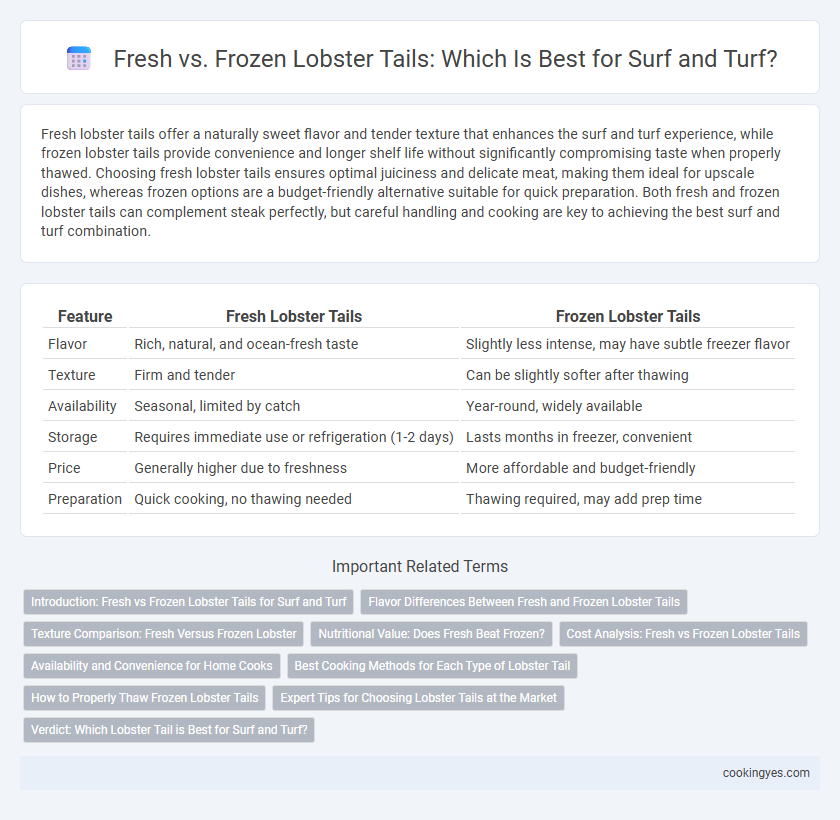Fresh lobster tails offer a naturally sweet flavor and tender texture that enhances the surf and turf experience, while frozen lobster tails provide convenience and longer shelf life without significantly compromising taste when properly thawed. Choosing fresh lobster tails ensures optimal juiciness and delicate meat, making them ideal for upscale dishes, whereas frozen options are a budget-friendly alternative suitable for quick preparation. Both fresh and frozen lobster tails can complement steak perfectly, but careful handling and cooking are key to achieving the best surf and turf combination.
Table of Comparison
| Feature | Fresh Lobster Tails | Frozen Lobster Tails |
|---|---|---|
| Flavor | Rich, natural, and ocean-fresh taste | Slightly less intense, may have subtle freezer flavor |
| Texture | Firm and tender | Can be slightly softer after thawing |
| Availability | Seasonal, limited by catch | Year-round, widely available |
| Storage | Requires immediate use or refrigeration (1-2 days) | Lasts months in freezer, convenient |
| Price | Generally higher due to freshness | More affordable and budget-friendly |
| Preparation | Quick cooking, no thawing needed | Thawing required, may add prep time |
Introduction: Fresh vs Frozen Lobster Tails for Surf and Turf
Fresh lobster tails offer a delicate texture and sweet flavor that enhances any surf and turf dish, prized for their natural moisture and succulent meat. Frozen lobster tails provide convenience and longer shelf life, often flash-frozen to preserve quality while allowing year-round availability. Choosing between fresh and frozen depends on recipe requirements, availability, and desired taste intensity for the perfect surf and turf experience.
Flavor Differences Between Fresh and Frozen Lobster Tails
Fresh lobster tails offer a delicate, naturally sweet flavor with a tender texture that enhances surf and turf dishes. Frozen lobster tails, often flash-frozen shortly after harvest, retain much of their flavor but can sometimes develop a slightly less vibrant taste due to ice crystal formation affecting meat fibers. Choosing fresh over frozen results in a more pronounced buttery richness, elevating the overall taste experience in gourmet meals.
Texture Comparison: Fresh Versus Frozen Lobster
Fresh lobster tails boast a tender, succulent texture with a natural firmness that enhances the surf and turf experience, offering a delicate bite easily distinguished from frozen varieties. Frozen lobster tails often have a slightly softer or mushier texture after thawing due to ice crystal formation damaging the meat's cellular structure, resulting in a less desirable mouthfeel. Choosing fresh lobster ensures optimal texture and flavor, making it the preferred choice for gourmet surf and turf dishes.
Nutritional Value: Does Fresh Beat Frozen?
Fresh lobster tails often retain higher levels of delicate nutrients such as omega-3 fatty acids and vitamin B12 compared to frozen counterparts, which may experience slight nutrient degradation during freezing and thawing. However, frozen lobster tails are typically flash-frozen at peak freshness, helping preserve most of the essential proteins and minerals like zinc and selenium necessary for a balanced surf and turf meal. Both fresh and frozen lobster tails offer excellent nutritional value, but fresh options may provide a marginal edge in nutrient density and flavor profile.
Cost Analysis: Fresh vs Frozen Lobster Tails
Frozen lobster tails generally offer a cost advantage over fresh tails, often priced 20-30% lower due to extended shelf life and reduced spoilage risk. Fresh lobster tails demand premium pricing driven by limited availability, higher handling costs, and the need for rapid transportation to maintain quality. For surf and turf dishes, frozen lobster tails provide a budget-friendly alternative without significant compromise on flavor and texture when properly thawed.
Availability and Convenience for Home Cooks
Fresh lobster tails offer superior flavor and texture but are often limited by seasonal availability and higher prices, making them less convenient for home cooks. Frozen lobster tails provide year-round access, extended shelf life, and easy portion control, ensuring consistent quality without compromising taste. For surf and turf dishes, frozen tails deliver unmatched convenience and reliability, ideal for busy home kitchens.
Best Cooking Methods for Each Type of Lobster Tail
Fresh lobster tails are best grilled or broiled to preserve their sweet, delicate flavor and tender texture, ensuring a juicy surf and turf experience. Frozen lobster tails benefit from gentle thawing followed by steaming or baking, which helps retain moisture and enhance the natural seafood taste. Choosing the correct cooking method based on lobster tail freshness ensures optimal flavor and succulent results.
How to Properly Thaw Frozen Lobster Tails
Properly thaw frozen lobster tails by placing them in the refrigerator for 8 to 12 hours, allowing them to thaw gradually and maintain their delicate texture. For a quicker method, submerge sealed lobster tails in cold water for 30 to 60 minutes, changing the water every 15 minutes to ensure even thawing. Avoid thawing at room temperature to prevent bacterial growth and preserve the lobster's freshness for optimal surf and turf dishes.
Expert Tips for Choosing Lobster Tails at the Market
When selecting lobster tails for surf and turf, prioritize fresh lobster tails for their superior texture and natural sweetness, which enhance the dish's overall flavor profile. If fresh options are unavailable, choose frozen lobster tails that are vacuum-sealed to prevent freezer burn and retain moisture. Look for tails with firm, translucent flesh and avoid those with discoloration or ice crystals to ensure optimal quality and taste.
Verdict: Which Lobster Tail is Best for Surf and Turf?
Fresh lobster tails offer superior flavor and texture, making them ideal for a premium surf and turf experience as they retain natural sweetness and firmness. Frozen lobster tails provide convenience and year-round availability, but may lose some moisture and delicate taste during freezing and thawing. For the best surf and turf dish, fresh lobster tails are generally preferred for their enhanced quality and culinary performance.
Fresh vs frozen lobster tails for surf and turf Infographic

 cookingyes.com
cookingyes.com